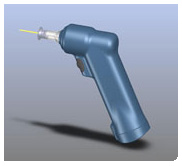From
Medpagetoday.com:
Life-threatening anaphylactic reactions to foods are under-diagnosed and under-treated, both in the community and in the emergency room, according to researchers here.
So found two studies -- from Massachusetts General Hospital in Boston and the Albany (N.Y.) Medical College -- that were reported at the American Academy of Allergy, Asthma, and Immunology meeting here.
"Anaphylaxis has for decades been considered a rare disease, even by physicians, even by other health care professionals," said F. Estelle R. Simons, M.D., of the University of Manitoba in Winnipeg, who is president of the American Academy of Allergy, Asthma and Immunology.
But in fact, the rate of anaphylaxis -- not just anaphylactic shock, but any type of acute, severe allergic reaction -- is likely much higher than published estimates, said Dr. Simons, because many episodes of anaphylaxis occur outside the emergency room.
"They experience anaphylaxis at home, at school, at camp, or on a plane or a bus or wherever they may happen to be," she said.
A consensus panel of the National Institute of Allergy and Infectious Diseases defined anaphylaxis as "acute onset of illness (within minutes to several hours) with involvement of the skin, mucosal tissue or both," following exposure to an allergenic substance, combined with one or more of the following: respiratory compromise, reduced blood pressure or associated symptoms of end-organ dysfunction, involvement of skin or mucosal tissues such as hives, and persistent gastrointestinal symptoms."
But even when anaphylaxis is recognized correctly in the emergency room, only about half of the patients receive epinephrine to treat it, although about a quarter of all such patients have symptoms serious enough to require hospitalization, reported researchers at Massachusetts General Hospital and Harvard Medical School.






